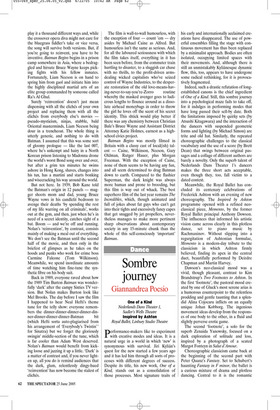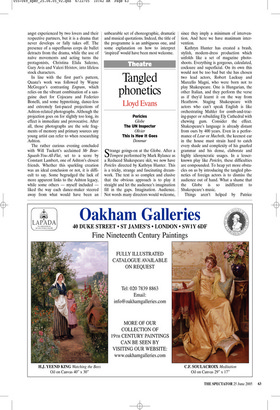Sombre journey
Giannandrea Poesio
One of a Kind Nederlands Dans Theater 1, Sadler’s Wells Theatre Inspired by Ashton Royal Ballet, Linbury Studio Theatre Performance-makers like to experiment with creative modes and ideas. It is a natural urge in a world in which ‘new’ is synonymous with survival. Jiri Kylián’s quest for the new started a few years ago and it has led him through all sorts of processes with different degrees of success. Despite its title, his new work, One of a Kind, stands out as a consolidation of those processes. Most signature traits of his early and internationally acclaimed creations have disappeared. The use of powerful ensembles filling the stage with continuous movement has thus been replaced by a minimalist approach. Bodies are often isolated, occupying limited spaces with their movements. And, although there is still an unmistakably Kyliánesque dynamic flow, this, too, appears to have undergone some radical rethinking, for it is provocatively fragmented.
Indeed, such a drastic refutation of longestablished canons is the chief ingredient of One of a Kind. Still, this sombre journey into a psychological maze fails to take off, for it indulges in performing modes that have long passed their sell-by date. Both the limitations imposed by quirky sets (by Atsushi Kitagawara) and the interaction of the dancers with suspended geometric forms and lighting (by Michael Simon) are trite and old hat. Similarly, the repeated choreographic challenges to the classical vocabulary and the use of a score (by Brett Dean) that swings between original passages and a collage of different authors are barely a novelty. Only the superb talent of Nederlands Dans Theater 1’s dancers makes the three short acts acceptable, even though they, too, fall victim to a dated context.
Meanwhile, the Royal Ballet has concluded its centenary celebrations of Frederick Ashton with an evening of new choreography. The Inspired by Ashton programme opened with a refined neoclassical piece, Memento, by the former Royal Ballet principal Anthony Dowson. The influences that informed his artistic vision came across clearly in this plotless dance, set to piano music by Rachmaninov. Without slipping into a regurgitation of Ashtonian formulae, Memento is a modern-day tribute to the classicism in which Ashton firmly believed, finding its apex in the central duet, beautifully performed by Deirdre Chapman and Martin Harvey.
Dawson’s neo-classical mood was a vivid, though pleasant, contrast to Kim Brandstrup’s Two Footnotes to Ashton. In the first ‘footnote’, the pastoral mood created by one of Gluck’s most serene arias is a humorous counterpoint to the relentless prodding and gentle taunting that a splendid Alina Cojocaru inflicts on an equally unique Johan Kobborg. The ingenious movement ideas develop from the responses of one body to the other, in a fluid and slightly perverse erotic game.
The second ‘footnote’, a solo for the superb Zenaida Yanowsky, focused on a dark exploration of solitude and loss, inspired by a photograph of a seated Margot Fonteyn in Salut d’Amour.
Choreographic classicism came back at the beginning of the second part with Peter Quanz’s Fantasy. Set to Schubert’s haunting Fantasy in F minor, the ballet is a curious mixture of drama and plotless dancing. Central to it is the romantic angst experienced by two lovers and their respective partners, but it is a drama that never develops or fully takes off. The presence of a superfluous corps de ballet detracts from the drama, while the use of naïve movements and acting turns the protagonists, Christina Elida Salerno, Gary Avis and Valeri Hristov, into lifeless stock characters.
In line with the first part’s pattern, Quanz’s work was followed by Wayne McGregor’s contrasting Engram, which relies on the vibrant combination of a sanguine duet for Cojocaru and Federico Bonelli, and some hypnotising, dance-less and extremely fast-paced projections of Ashton-related photographs. Although the projection goes on for slightly too long, its effect is immediate and provocative. After all, those photographs are the sole fragments of memory and primary sources any young artist can refer to when researching Ashton.
The rather curious evening concluded with Will Tuckett’s acclaimed Mr BearSquash-You-All-Flat, set to a score by Constant Lambert, one of Ashton’s closest friends. Whether this sparkling creation was an ideal conclusion or not, it is difficult to say. Some begrudged the lack of more apparent links to the Ashton legacy, while some others — myself included liked the way each dance-maker steered away from what would have been an unbearable set of choreographic, dramatic and musical quotations. Indeed, the title of the programme is an ambiguous one, and some explanation on how to interpret ‘inspired’ would have been most welcome.



































































 Previous page
Previous page